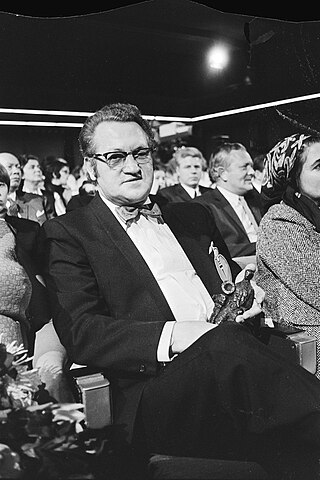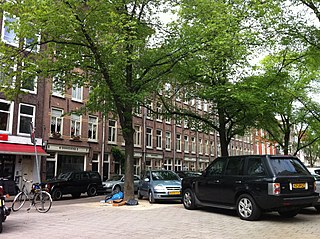
The Jordaan is a neighbourhood of the city of Amsterdam, Netherlands. It is part of the borough of Amsterdam-Centrum. The area is bordered by the Singelgracht canal and the neighbourhood of Frederik Hendrikbuurt to the west; the Prinsengracht to the east; the Brouwersgracht to the north and the Leidsegracht to the south. The former canal Rozengracht is the main traffic artery through the neighbourhood.

Johnny Jordaan was the pseudonym for Johannes Hendricus van Musscher, a Dutch singer of popular music, in particular the genre known as levenslied, a Dutch variety of the French chanson. He was well known for his songs about the city of Amsterdam, especially the Jordaan district, which he sang in a typical "hiccuping Mokum vibrato", "Mokum" being the Hebrew-derived nickname for the Amsterdam inner city area. In the 1950s, Johnny Jordaan rose almost instantly to the level of national celebrity and became the "uncrowned king of the Jordaanlied", and his hit song "Geef mij maar Amsterdam" is one of the songs Amsterdammers identify with most.
Paul Roos Gymnasium is a public, dual medium high school for boys in the town of Stellenbosch in the Western Cape province of South Africa, which opened on 1 March 1866 as Stellenbosch Gymnasium. It is the 12th oldest school in the country.

Theuns Jordaan was a South African singer-songwriter.

Many people of European heritage in South Africa are descended from Huguenots. Most of these originally settled in the Cape Colony, but were absorbed into the Afrikaner and Afrikaans-speaking population, because they had religious similarities to the Dutch colonists.

Titus van Rijn was the fourth and only surviving child of Rembrandt Harmenszoon van Rijn and Saskia van Uylenburgh. Titus is best known as a figure or model in his father's paintings and studies but also because of a legal case as preferential heir.

Jacob J. Hinlopen lived in a house with Hinlopen in the gable, now at 155 Nieuwendijk. He traded in cloth and Indian wares. In 1602 he was co-founder of the Dutch East India Company in Enkhuizen: his descendants inherited very old stocks. In 1617 he became the first person of Flemish origin to obtain a seat on the City Council.
Hoërskool Jan van Riebieck is a public co-educational high school situated in Gardens in Cape Town in the Western Cape province of South Africa. It was founded in 1926 by J.J. Jordaan and educates in both Afrikaans and English language.
Bij ons in de Jordaan is a 2000 Dutch television series directed by Willem van de Sande Bakhuyzen, a biography of the singer Johnny Jordaan.

Mark van Vugt is a Dutch evolutionary psychologist who holds a professorship in evolutionary psychology and work and organizational psychology at the VU University Amsterdam, the Netherlands. Van Vugt has affiliate positions at the University of Oxford, Institute for Cognitive and Evolutionary Anthropology (ICEA).

De Notenkraker was a Dutch political and satirical weekly magazine published between 1907 and 1936.

The Jordaanlied is a type of levenslied, the Dutch genre of nostalgic sentimental popular music; the Jordaanlied hails from and sings the praises of the Amsterdam neighborhood the Jordaan which, until the 1960s, was an impoverished working-class area. The genre first came to the fore in the late 19th century and reached extraordinary popularity in the 1950s, before becoming old-fashioned quickly when rock and roll came along. It continues to be sung in the now-yuppified Jordaan, as a local favorite and a tourist attraction in a profoundly changed neighborhood; already a nostalgic genre when it was first made popular, the situations it describes and the emotions it evokes are no longer directly accessible even by the older generations, a transformation due in part to the Jordaanlied itself.
Snapplify is an edtech company, specialising in digital education content, related educational services, and devices. Snapplify is an African ebook aggregator and distributor, with an ebook offering of 240 000 titles from about 250 publishers. Snapplify has worked with many schools across Africa, offering them digital education tools.

Tante Leen, real name Helena Kok-Polder, later Helena Jansen-Polder, was a Dutch folk singer from Amsterdam, Netherlands. Together with her friend and colleague Johnny Jordaan, the two together hold the title of "de Beste Stem van de Jordaan".

The Weerbaarheidsafdeling was the paramilitary arm of the National Socialist Movement in the Netherlands (NSB), the fascist political party that collaborated with the German occupiers of the Netherlands during World War II. The organization, roughly equivalent to the German SA, was founded in 1932 by Anton Mussert, co-founder of the NSB in 1931 and its leader until the end of the war. Members wore and marched in black uniforms and were thus called "blackshirts". In 1933 the Dutch government banned the wearing of uniforms, and the WA was disbanded in 1935 in order to forestall the Dutch government's banning it. In 1940, after the German invasion, the WA became openly active again, and more ruthless than before. They specialized in violent attacks, particularly on the Dutch Jewish population.

The Bloemgracht is a canal in the Jordaan district of Amsterdam, the Netherlands. It connects the Prinsengracht with the Lijnbaansgracht and runs between and parallel to Nieuwe Leliestraat and Bloemstraat in the Amsterdam-Centrum district. The canal is named after the bulwark "de Bloem", later called "Rijkeroord". From 1614 a windmill was located here, but it was moved to Haarlemmerweg in 1878.

The Elandsgracht is a street and former canal in Amsterdam, the Netherlands. It runs between the Prinsengracht and the Singelgracht in the Jordaan neighborhood of the Amsterdam-Centrum district. Bridge 169 over the Singelgracht and Bridge 107 over the Lijnbaansgracht connect the Elandsgracht in the direction of the Kinkerstraat. The Elandsgracht is in the west of the Grachtengordel. The Elandsstraat runs parallel to the Elandsgracht. There are houses, shops, cafés and restaurants on the former canal, with parking spaces in the middle.

The Lindengracht is a street and former canal in Amsterdam. It is in the Jordaan neighborhood of the Centrum district just west of the canal belt. The canal was back-filled in 1895. It connected the Brouwersgracht with the Lijnbaansgracht. The Eerste Lindendwarsstraat and Tweede Lindendwarsstraat are side streets. Lindenstraat runs parallel to the Lindengracht.

Helena Mercier (1839–1910) was a Dutch social-liberal feminist, a social reformer, a writer, and one of the founders of the idea of social work in the Netherlands.














